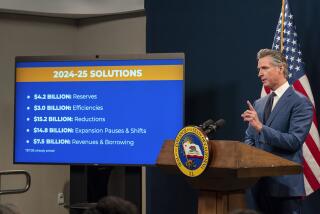Capitol Journal: Newsom’s budget for California shows liberal Democrats are firmly in control

Reporting from Sacramento — These are some highlights — lowlights? — of a new state budget crafted by Gov. Gavin Newsom and the heavily Democratic Legislature:
— Government health insurance for young adult immigrants living here illegally.
— A $1.7-billion income tax increase to finance a wealth redistribution program called the earned income tax credit.
— A drinking water cleanup effort funded by fees collected to reduce climate-altering greenhouse gas emissions. If there’s a connection between clean water and climate change no one has explained it, at least not convincingly.
In past legislative eras, these budget provisions — especially the first two — would have been shunned as lowlights, not cheered as highlights.
But liberal Democrats are now in firm control of the state Capitol with arguably the most leftist governor ever and supermajorities in the Legislature. That’s because they accurately represent the Democrat-dominated California electorate. That’s the way it’s designed to work.
Anyone with a beef about Sacramento politics should blame Republicans. That’s because they’ve allowed themselves to become so weak they’re irrelevant on any issue not requiring a two-thirds supermajority vote, such as a tax increase. They only become players when a bill — perhaps a tax hike — is so liberal Assembly moderates can’t stomach it and lean Republican.
This increasing Democratic dominance is largely due to changing demographics. The nonpartisan Public Policy Institute of California reported last year that 77% of likely Republican voters were white and only 23% people of color. That’s a coalition without a future in this state. Democratic likely voters were split evenly — 50% white and 50% people of color.
Gov. Gavin Newsom abandons water tax, rejects some new spending in California budget deal »
But back to the budget.
It totals nearly $215 billion: $148 billion general fund, $61 special funds, $6 billion bonds. The main budget bill must be sent to the governor by Saturday night or legislators will lose their pay. They’ll avoid that at any cost. But passage of several supplemental “trailer bills” will string out for days.
About those highlights:
Under current law, undocumented children up to age 19 are eligible for Medi-Cal, the state healthcare program for the poor. The new budget extends that eligibility to age 26. The cost: $98 million annually.
An estimated 90,000 undocumented young adults will become eligible for full Medi-Cal coverage. It’s the latest help by the state for immigrants here illegally. But for Newsom, it’s apparently less about undocumented immigrants than it is about gradually making sure every Californian has healthcare coverage. He campaigned for election on that.
“This is in the larger context of our goal of universal coverage,” says Daniel Zingale, a Newsom senior advisor.
“We want everyone to have access to preventive care. It’s relatively low cost. We want them to keep healthy so they can stay out of very costly hospital emergency rooms.
“[Gov.] Jerry Brown did it for the kids. This is the next step. And the vision for this governor and legislative leaders is to have everyone covered. We can’t do it all in one leap. But this is another big step forward.”
Zingale adds: “This governor regards [undocumented immigrants] as Californians. They pay taxes, work at jobs, they’re our neighbors. The vast majority play by the rules. Excluding them from access to healthcare doesn’t make sense. This doesn’t entitle them to anything other Californians aren’t entitled to.”
Several Democratic legislators wanted to make all adults living here illegally eligible for Medi-Cal. But Newsom nixed that, saying it would cost more than $3 billion.
Going, going ... with midterm wipeout, California Republican Party drifts closer to irrelevance »
Newsom’s plan also includes subsidizing medical insurance for middle-class individuals earning up to $72,000 a year and families of four making up to $150,000. That’s the good part. The bad piece is it would be paid for by hefty fines on Californians who don’t buy healthcare coverage.
The $1.7-billion income tax hike is not something most people need to worry about, even if the description is a bit scary: It conforms some of California’s tax law to President Trump’s controversial tax overhaul of 2017. But it affects relatively few people.
Moreover, some moderate Democrats in the Assembly are balking and it’s not a done deal yet. A two-thirds majority vote is required.
H.D. Palmer, spokesman for the state finance department, says if the $1.7-billion tax increase isn’t passed, there won’t be money for the earned income tax credit largesse. Newsom’s plan would triple the credits from $400 million annually to $1.2 billion, and increase eligibility from 2 million working poor to 3 million.
“If we don’t have [tax] conformity, we don’t have money for the program,” Palmer says. “They’re not separable. We can’t do EITC and not conformity.”
The tax proposal’s biggest hit by far is worth $1.3 billion. It would limit the amount of business losses — on housing rentals, for example — that could offset personal income.
Gov. Gavin Newsom faces a big political test as he shapes his first California budget »
On water, more than 1 million people don’t have safe water to bathe in or drink. Newsom wanted to slap a 95-cent tax on every water bill to fix the problem. The Legislature was skittish. After all, the state has a roughly $20-billion surplus.
So lawmakers tapped into the so-called cap-and-trade fund, which legally can only be spent on programs to fight climate change. A budget writer rationalized that if someone had to drive a car to buy bottled water, it would emit greenhouse gas emissions. So spending the cap-and-trade revenue was justified.
Typical government explanation.
But about the last thing Californians need right now is another tax increase.
Follow @LATimesSkelton on Twitter
More to Read
Get the L.A. Times Politics newsletter
Deeply reported insights into legislation, politics and policy from Sacramento, Washington and beyond. In your inbox three times per week.
You may occasionally receive promotional content from the Los Angeles Times.











